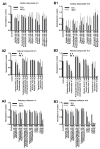Suppression of mRNA Nanoparticle Transfection in Human Fibroblasts by Selected Interferon Inhibiting Small Molecule Compounds
- PMID: 28758979
- PMCID: PMC5618237
- DOI: 10.3390/biom7030056
Suppression of mRNA Nanoparticle Transfection in Human Fibroblasts by Selected Interferon Inhibiting Small Molecule Compounds
Abstract
In vitro transcribed (IVT) mRNA is increasingly applied in lieu of DNA to deliver reprogramming genes to fibroblasts for stem cell derivation. However, IVT mRNA induces interferon (IFN) responses from mammalian cells that reduces transfection efficiency. It has been previously suggested that small molecule inhibitors of IFN are a viable strategy to enhance mRNA transfection efficiency. Herein, we screen a list of commercially available small molecules, including published IFN inhibitors, for their potential to enhance mRNA transfection in BJ fibroblasts. Transfection enhancement is quantified by relative mean fluorescence intensity of translated green fluorescent protein (GFP) in treated cells compared to dimethyl sulfoxide treated controls. Within toxicological constrains, all tested small molecules did not enhance mRNA transfection in BJ fibroblasts while a third of the tested compounds unexpectedly inhibited GFP expression even though IFN-β production is inhibited. Based on the results of our study, we conclude that small molecule inhibitors, including IFN inhibitors, tested in this study do not enhance in vitro mRNA transfection efficiency in human fibroblasts.
Keywords: interferon; mRNA delivery; small molecules; transfection.
Conflict of interest statement
All authors have no competing financial interests.
Figures



Similar articles
-
Negative modulation of alpha1(I) procollagen gene expression in human skin fibroblasts: transcriptional inhibition by interferon-gamma.J Cell Physiol. 1999 Apr;179(1):97-108. doi: 10.1002/(SICI)1097-4652(199904)179:1<97::AID-JCP12>3.0.CO;2-E. J Cell Physiol. 1999. PMID: 10082137
-
Differential effects of toll-like receptor stimulation on mRNA-driven myogenic conversion of human and mouse fibroblasts.Biochem Biophys Res Commun. 2016 Sep 23;478(3):1484-90. doi: 10.1016/j.bbrc.2016.08.159. Epub 2016 Aug 29. Biochem Biophys Res Commun. 2016. PMID: 27586271 Free PMC article.
-
Defining optimized properties of modified mRNA to enhance virus- and DNA- independent protein expression in adult stem cells and fibroblasts.Cell Physiol Biochem. 2015;35(4):1360-71. doi: 10.1159/000373957. Epub 2015 Feb 12. Cell Physiol Biochem. 2015. PMID: 25720503
-
Synthetically modified mRNA for efficient and fast human iPS cell generation and direct transdifferentiation to myoblasts.Biochem Biophys Res Commun. 2016 May 6;473(3):743-51. doi: 10.1016/j.bbrc.2015.09.102. Epub 2015 Oct 9. Biochem Biophys Res Commun. 2016. PMID: 26449459 Review.
-
mRNA-based therapies: Preclinical and clinical applications.Int Rev Cell Mol Biol. 2022;372:1-54. doi: 10.1016/bs.ircmb.2022.04.007. Epub 2022 Jun 3. Int Rev Cell Mol Biol. 2022. PMID: 36064262 Review.
Cited by
-
Myocarditis following COVID-19 vaccination: incidence, mechanisms, and clinical considerations.Expert Rev Cardiovasc Ther. 2022 Apr;20(4):241-251. doi: 10.1080/14779072.2022.2066522. Epub 2022 Apr 18. Expert Rev Cardiovasc Ther. 2022. PMID: 35414326 Free PMC article. Review.
-
The Epidemiology of COVID-19 Vaccine-Induced Myocarditis.Adv Med. 2024 Apr 18;2024:4470326. doi: 10.1155/2024/4470326. eCollection 2024. Adv Med. 2024. PMID: 38681683 Free PMC article. Review.
-
Strategies for controlling the innate immune activity of conventional and self-amplifying mRNA therapeutics: Getting the message across.Adv Drug Deliv Rev. 2021 Sep;176:113900. doi: 10.1016/j.addr.2021.113900. Epub 2021 Jul 26. Adv Drug Deliv Rev. 2021. PMID: 34324884 Free PMC article. Review.
-
Corticosteroids and cellulose purification improve, respectively, the in vivo translation and vaccination efficacy of sa-mRNAs.Mol Ther. 2021 Apr 7;29(4):1370-1381. doi: 10.1016/j.ymthe.2021.01.023. Epub 2021 Jan 21. Mol Ther. 2021. PMID: 33484964 Free PMC article.
References
-
- Van der Jeught K., Joe P.T., Bialkowski L., Heirman C., Daszkiewicz L., Liechtenstein T., Escors D., Thielemans K., Breckpot K. Intratumoral administration of mRNA encoding a fusokine consisting of IFN-beta and the ectodomain of the TGF-beta receptor II potentiates antitumor immunity. Oncotarget. 2014;5:10100–10113. doi: 10.18632/oncotarget.2463. - DOI - PMC - PubMed
Publication types
MeSH terms
Substances
LinkOut - more resources
Full Text Sources
Other Literature Sources

